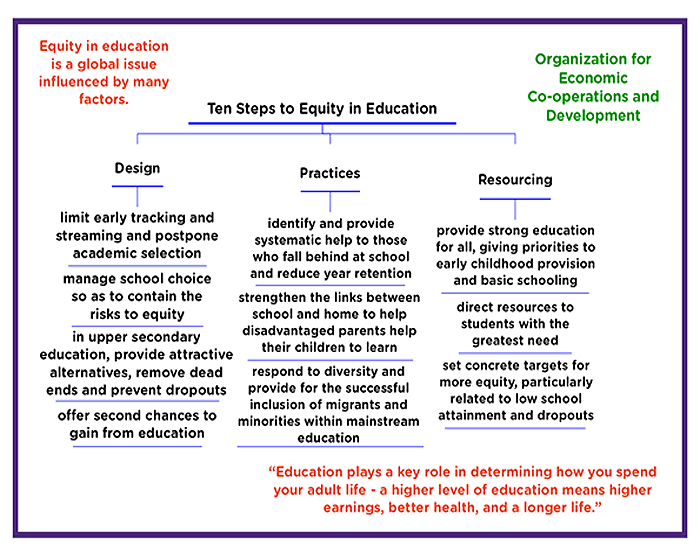Introduction
Equity in education does not imply that all students have the same educational outcomes; instead, it means that any variations in results are unconnected to factors such as students' socioeconomic backgrounds. Postsecondary education credentials, such as university degrees, are increasingly important for students to enter the workforce and achieve their professional and personal goals. Educational equity necessitates that all students have an equal opportunity to do so, regardless of their socioeconomic background.
Dimensions:
The Organisation for Economic Co-operation and Development (OECD) identifies two interconnected aspects of educational equity.
1. Fairness
It ensures that neither individual nor societal factors prevent people from reaching their full academic potential. Discrimination based on gender, race, or economic status is outlawed.
2. Inclusion
Guaranteeing everyone access to at least some form of formal education. The ability to read, write, and do basic maths is only one example of a set of skills that everyone should have. It is only fair that those children, who require additional resources to succeed, be given them. Equity promotion in the classroom and school many things can be done on a school- and classroom-by-school basis to create a more equitable environment for children, even if other issues of equity in education need to be addressed on a more significant systemic scale. Understanding each student's unique requirements and crafting learning experiences that benefit all students is crucial to achieving educational equity. All students receive the individual attention and the academic scaffolding they need to reach their full potential in an equitable classroom.
Fostering Learners' Independence and Growth At its core, creating a more just school climate is a matter of student agency, or in other words, ensuring that every student is equipped with the resources they need to thrive in school and beyond. Those kids include those in the Gifted and Talented program, those who are English Language Learners (ELLs), and those in Special Education. To better serve its expanding English Language Learner (ELL) student body, the Cherry Creek School District in Colorado implemented two initiatives, Path to Proficiency and Thinking Maps.

A Fair Opportunity To Flourish
Ultimately, educational equality is about giving every student a voice in the classroom and the tools they need to succeed academically and in life. Empowering all pupils in this way has far-reaching positive effects on the economy, culture, and politics, laying the groundwork for prosperous households, neighbourhoods, and institutions.
Challenges Involving Equity And Equality In Schools
Many different groups, differentiated by race, gender, socioeconomic status, and other variables, may be harmed by the absence of inclusive education. In addition to the people being singled out, our methods to address these problems are also at the heart of the debate. Most schools prioritise horizontal equity when addressing issues of fairness in the classroom. Horizontal equity in education means providing the same educational opportunities to students presumed to be of similar ability. To be effective, horizontal equity can only be implemented in schools where students have very similar backgrounds and experiences. Some students at a given school may come from wealthier households than others, but this is not uncommon. Therefore, educators should prioritise vertical equity, recognizing that each student has unique requirements and allocating resources accordingly.
Help Disadvantaged Students And Schools Improve
Schools that serve many economically disadvantaged pupils are more likely to underperform, with ripple effects throughout entire school districts. School administrators and instructors and school, classroom, and neighbourhood environments often fail to offer a high-quality learning experience for the most disadvantaged. As a result, low-performing underprivileged schools often lack the internal capacity and support to improve.
What Are The Benefits Of Equity In Education?
The classroom climate improves when students access materials explicitly designed for them. The positive effects of equity on pupils' social and emotional growth have been demonstrated in other research. Students of all backgrounds and abilities will be more likely to show compassion and kindness to others if they are exposed to and learn from the variety and are given opportunities to build empathy. Every academic and broader community member benefits from equity in some way. Imagine a student without adequate schooling and guidance is more likely to be chronically absent and less likely to complete secondary school and continue to postsecondary education. If the resources that students need are made available, they will have a better chance of succeeding academically and developing into productive adults.

Conclusion:
Governments that invest in education from childhood through high school have the best chance of seeing a return on their money. To decrease student failure and dropout rates, governments should take two parallel actions: (1) they can eliminate education laws and practices that impede equity, and (2) they can focus on low-performing underprivileged schools. However, for students to succeed, government education policies must be coordinated with other programs, such as housing or welfare.



